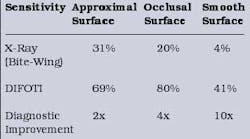I read your article on "Caries Detection" in the March/April issue of Woman Dentist Journal with great interest. I want to alert you to two significant factual errors in the article regarding our DIFOTI system.
First, you state that "DIFOTI is less sensitive in the detection of occlusal caries ..." and cite three articles. This is not correct. It has been demonstrated that DIFOTI is more sensitive than radiography for detection of occlusal caries. I believe that you may have confused DIFOTI with traditional FOTI. The references you cite — 18 through 20 — refer to studies with FOTI, not DIFOTI.
Although both use transillumination, DIFOTI enables detection of occlusal caries with superior sensitivity to radiography and has FDA approval and patents for reproducible imaging of the coronal tooth surfaces listed below.
In NIH-NIDCR-sponsored clinical studies, with cross-sectioning pathology as the gold standard, dentists comparing DIFOTI to bite-wing film radiographic images (which have higher resolution than digital radiographic images) were able to detect the following:
After seeing DIFOTI images, dentists were able to see twice as much caries on the inter-proximal surface, four times more on the occlusal, and 10 times more on the smooth surface. This was after only a few hours of learning how to interpret DIFOTI images, as opposed to years of training in radiographic image interpretation. These results were published in Caries Research (Schneiderman A, Elbaum M, et. al. Assessment of Dental Caries with Digital Imaging Fiber-Optic Transillumination (DIFOTI): In vitro Study. Caries Research 1997, 31:103-110).
Second, you repeat this error in your table by indicating with a question mark that DIFOTI has the potential to detect fissures and facial/lingual caries. DIFOTI enables detection of fissure/occlusal caries, interproximal caries, and smooth-surface caries with superior sensitivity to radiography. In the images reproduced in your article, one has clear examples of occlusal, interproximal, and smooth-surface caries obtained with DIFOTI.
We would appreciate it if you could inform your readers of these comments so that they are not under a mistaken impression regarding DIFOTI's diagnostic capabilities and how it differs significantly from traditional FOTI.
Martin Krusin
Director of DIFOTI Development, Electro-Optical Sciences, Inc.
Irvington, N.Y.
The establishment of another vehicle, Woman Dentist Journal, to support and encourage the professional development of women dentists is a positive contribution to our career environment. For practicing dentists, it may serve as a vehicle for sharing new techniques, case studies, and professional development expertise. For women faculty working toward promotion and tenure, the journal will be an additional resource to support scholarship and professional achievement.
We encourage our colleagues who are interested in sharing knowledge, helping to shape the future of dental practice, and contributing to the advancement of dental education and research to consider careers in academia. For specialists and general practitioners alike, the rewards of mentoring young, enthusiastic dental students — eager to learn from you and your experience — are gratifying.
Paula K. Friedman, DDS, MSD, MPH
President, American Dental Education Association







